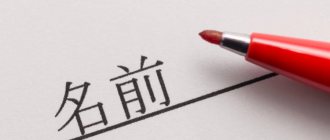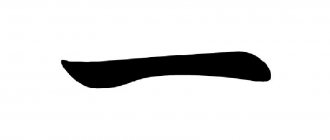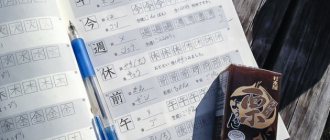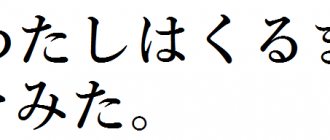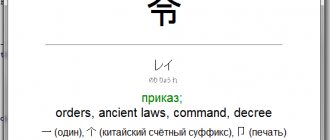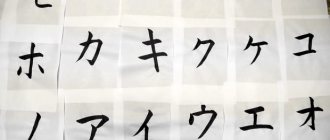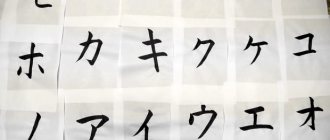Do you know how to say “hello!” in Japanese? No? Then this article will be useful to you. Every language has a set of basic phrases that are used every day. Say hello, as we have already indicated, thank you, apologize. Naturally, such phrases also exist in Japanese. It is simply necessary to know them - without them, everyday life will become impossible, and further study of the Japanese language will stall. Below in the tables we post a list of basic phrases in Japanese with transcription and translation. Get ready to memorize!
Acquaintance
When interlocutors first get to know each other, they usually first talk about themselves and express hope for mutual support. In Japanese this is called 自己紹介 - "jikosho kai", which can literally be translated as "self-presentation". A sort of self-presentation. an established pattern in Japanese society .
It should be noted that the Japanese language has several levels of politeness . Here, with the exception of some points, phrases of two levels will be presented. Polite/Formal - Suitable for all occasions. It is universal , at least in the initial stages. Informal is the level of politeness of speech among friends, close colleagues, and the like. Be careful in choosing your phrase - the wrong level of politeness will alienate a person or even offend him.
A small note: in transcription, the colon after a vowel indicates its length.
So, the first phrase in your story about yourself is 初めまして (はじめまして). It reads “hajimemashite” and translates as “nice to meet you.”
Then you say your name. Here are several options:
| Phrase in Japanese | Writing in Hiragana | Transcription | Translation |
| (私は)nameです。 | (わたしは)nameです。 | (Watashi wa) name des. | I am the name. The simplest and not too formal option. “Watashi wa” can be added or omitted. |
| 私は name と言います。 | わたしは name といいます。 | Watashi wa name is iimas. | My name is my name. This is a more complicated option, but also more impressive, if I may say so. |
| 私は name と申します。 | わたくしは name ともうします。 | Watakushi wa name to mo:shimas. | My name is my name. A very official and formal option. Used where appropriate. It's better to save it for important events. |
After the greeting, you need to tell about yourself. The Japanese usually perceive people based on their belonging to a place - a place of study, a place of work. This is as important as your name. There is usually only one pattern here - type of activity. Here are a few examples:
| Phrase in Japanese | Writing in Hiragana | Transcription | Translation |
| 学生です。 | がくせいです。 | Gakusei des. | I am a student. Including school students. |
| 大学生です。 | だいがくせいです。 | Daigakusei des. | I am a university student. |
| 医者です。 | いしゃです。 | Isya des. | I am a doctor. |
| 技師です。 | ぎしです。 | Gisi des. | I am an engineer. |
| 教師です。 | きょうしです。 | Kyo:shi des. | I'm a teacher. |
Naturally, if you already know how, you can use the genitive suffix の to add the name of the school or university where you study, or the company or institution where you work.
Then you can clarify your age if you already know the numerals - age 歳です。(age さいです。) . It is pronounced “age sai des” and translated “my age is years old.” If you haven’t learned the numerals yet, then you can safely omit this point.
The “self-introduction” ends with a template phrase in which the speaker expresses the hope that the acquaintance will be pleasant and strong. There are several options here too:
| Phrase in Japanese | Writing in Hiragana | Transcription | Translation |
| よろしくお願いします。 | よろしくおねがいします。 | Yoroshiku onegai shimas. | I hope for your goodwill! A fairly polite phrase suitable for any occasion. |
| よろしくお願いいたします。 | よろしくおねがいいたします。 | Yoroshiku onegai itashimas. | I hope for your goodwill! A very polite option for special occasions. |
| よろしく。 | よろしく。 | Yoroshiku. | Nice to meet. An informal option, suitable for friends. |
Let's see what happened in the end. This is the basic pattern for almost all cases , since it is polite enough:
初めまして。私はnameと言います。 occupationです。よろしくお願いします。
name といいます。occupation です。よろしくおねがいします。
Hajimemashite. Watashi wa name is iimas. occupation of des. Yoroshiku onegai shimas.
Nice to meet you. My name is name . I am an occupation . I count on your kindness.
The template can be changed at your discretion. Before the final phrase, information about your specialty, age, and hobby fits well. This will make your story about yourself more complete. However, if you are just starting to learn the basics of the Japanese language, the above phrases will be enough for you.
How to say "thank you" in a polite way in Japanese
The phrase arigato gozaimasu can be said to people with a higher status than you (bosses, teachers and those older than you in age). This phrase is translated as “thank you very much.” In addition, it can be used when communicating with close friends to express sincere gratitude.
A more polite form of expressing gratitude is domo arigato gozaimasu. You can use it in any situation, including at an official reception.
Greetings
Where would we be without the same “hello”? Any conversation begins with a greeting; the right phrase prepares the interlocutor for dialogue and attracts him to you.
| Phrase in Japanese | Writing in Hiragana | Transcription | Translation |
| こんにちは! | こんにちは! | Konnichiwa! | Hello! |
| おはようございます! | おはようございます! | Ohai: gozaimas! | Good morning! |
| おはよう! | おはよう! | Ohayo:! | Good morning! An informal option, for example, for friends. |
| こんばんは! | こんばんは! | Konbanwa! | Good evening! |
several etiquette phrases follow . The interlocutors show attention to each other’s affairs, thereby expressing participation.
For example, if you haven’t seen your friend for a long time, you can continue the conversation with the phrase お久しぶりです。(おひさしぶりです。) - “ohisashiburi des”, “long time no see”.
Then it is customary to inquire about how things are going with the interlocutor:
| Phrase in Japanese | Writing in Hiragana | Transcription | Translation |
| お元気ですか。 | おげんきですか。 | O genki des ka? | How are you? |
| はい、元気です。 | はい、げんきです。 | Hai, genki des. | OK, thank you. Neutral option. |
| お陰様で、元気です。 | おかげさまで、げんきです。 | O kage sama de, genki des. | OK, thank you. A more polite, but still neutral option. |
Do not forget that you, in turn, should also ask the interlocutor about his affairs, if the question was asked to you.
Then the dialogue runs its course, and you can conduct the conversation at your own discretion.
How to say "thank you" at work in Japanese
The world of workers has its own Japanese language. Many words and phrases are used only there. The same applies to “thank you.”
“OTSUKARESAMA” – “THANK YOU FOR THE WORK DONE”
Otsukaresama deshita . Thanks for the work you've done.
“Otsukaresama” is an expression that is always present in Japanese work culture. The Japanese use it to thank their colleagues for their work.
“OSORE IRIMASU” – A WAY TO THANK CLIENTS
おそれいります。 Osore irimasu. Thank you, dear client.
Osore irimasu is rarely used in Japanese daily life. However, it is an expression that is spoken at work. It is often used when people want to thank their clients.
This expression is often considered a more polite form of "sumimasen". But they can't apologize. “Osore irimasu” can also be used when you are incompetent in some matter and thank the person who explained it to you.
Gratitude
Gratitude is the key to the heart of a person in any culture, so the ability to thank is no less important than the ability to introduce yourself and greet the interlocutor. Here are a few ways you can express gratitude and also respond to it:
| Phrase in Japanese | Writing in Hiragana | Transcription | Translation |
| ありがとう! | ありがとう! | Arigato:! | Thank you! Informal and simplest option. |
| どうもありがとう! | どうもありがとう! | Do:mo arigato:! | Thank you very much! Still informal. |
| ありがとうございます! | ありがとうございます! | Arigato: gozaimas! | Thank you Polite option. |
| ありがとうございました! | ありがとうございました! | Arigato: gozaimashita! | Thank you Formal gratitude for what was done for you in the past , gratitude for the result . |
| どうもありがとうございます! | どうもありがとうございます! | Do: mo arigato: gozaimas! | Please accept my gratitude! The polite equivalent of the informal "thank you very much." |
| どうもありがとうございました! | どうもありがとうございました! | Do: mo arigato: gozaimashita! | Please accept my gratitude! A polite "thank you very much" for an action in the past . |
| いいえ。 | いいえ。 | I:uh. | My pleasure. An informal response to gratitude for friends. |
| こちらこそ。 | こちらこそ。 | Kotira askew. | No, thank you. If there is a reason, of course. |
| どういたしまして。 | どういたしまして。 | Do:itashimasite. | Do not mention it. The polite equivalent of "You're welcome." |
How to say "thank you" in Japanese to a friend
The phrase domo arigato can be used to thank your friends and acquaintances, as well as restaurant waiters and sellers. But you should not use this phrase when communicating with your boss or at official receptions.
You can also use the well-known arigato, which is a rather familiar expression. You can use this word when communicating with friends and relatives, as well as with people whose social status is no higher than yours.
There is another form of friendly gratitude that is more polite than arigatou: domo. We can say that this is something between familiarity and formality.
In general, the word domo means “very”, but is perceived as “thank you”, naturally, depending on the context.
This expression can be used when talking with a boss or teacher, or even at an official reception. However, if you need to be as polite as possible, then it is better to use the expressions discussed above, for example domo arigatou gozaimasu.
Apologies
Well, there are a lot of apologies in Japanese. It’s time to dedicate a separate article to them, so we suggest now considering only the most basic phrases intended for apologies.
| Phrase in Japanese | Writing in Hiragana | Transcription | Translation |
| すみません。 | すみません。 | Sumimasen. | I'm sorry. An analogue of the English “excuse me”. You haven't done anything wrong, you're just apologizing for the inconvenience. |
| ごめなさい。 | ごめなさい。 | Gomenasai. | Sorry. Similar to "sorry". This phrase asks for forgiveness for wrongdoings. |
You can read more about Japanese apologies here: How to apologize in Japanese? We apologize in Japanese.
How to say: “Thank you, no need.” in Japanese
There are many ways to say, “No thanks.” in Japanese. We will tell you about four of them. They are arranged from the most formal to the most friendly.
“KYOKO DESU” – POLITE WAY
Ie, kyoko desu . Thank you, that's enough.
Keko is an adjective that means “enough.” When you say, “Ie, keko desu,” you literally mean that what you already have is enough for you. Typically this expression can be used when you are ordering at a restaurant or bar in Japan.
"Ie" literally means "no." This part can be omitted because saying “no” is considered impolite in Japanese. So it's better to just use "keko desu" if you don't want to seem arrogant or rude.
“DAIZHOBU” – WHEN EVERYTHING IS OKAY
だいじょうぶ。 Daijōbu. I'm fine.
You can say that everything is fine using the expression: "daijobu". This expression is much less polite than "kyo desu". I advise you to use "daijoba" only with close friends.
"AI" - SHORT VERSION
いいです。 Ii desu. I'm fine.
"Ii" literally means "good." This expression is even less polite than "daijobu". It can be used with someone you don't like or when you are upset. For example, this is how you can respond to someone who pesters you on the street or tries to apologize.
“OOKINI KANGAETOKIMASU” – KANSAI VERSION
Ookini, kangaetokimasu . No, thanks.
With this expression, which contains "ookini", you can say: "Thanks, no need." in the Kansai region, especially in Osaka. Do not attempt to use it outside of Kyoto, Osaka and surrounding cities. People may laugh at you.
Source
Phrases at home
It would seem what phrases are at home. “My home is my castle,” says the famous English saying. However, even here there are everyday expressions that you may not even notice.
| Phrase in Japanese | Writing in Hiragana | Transcription | Translation |
| 行ってきます! | いってきます! | Ittekimas! | I left! A phrase you say when leaving the house. |
| いってらっしゃい! | いってらっしゃい! | Itterassy! | Come back! The answer to the phrase above. |
| 只今! | ただいま! | Tadaima! | Hello, here I am! When you return home. |
| お帰りなさい! | おかえりなさい! | Okaeri nasai! | Welcome back! The answer to the phrase above. |
| いただきます! | いただきます! | Itadakimas! | Bon appetit! Not only at home, but anywhere. |
"Thank you" in Japanese slang
“SANKEW” – IN THE ENGLISH MANNER
サンキュ。 Senkyu. Thank you.
"Senkyu" is a phonetic transcription of "Thank you" in Japanese. This expression is used by young people.
This conversion originated from the Japanese alphabet used to transcribe foreign words. The name of this writing system is katakana. It is a syllabary that cannot transcribe all the sounds of the English language. This is why the Japanese pronounce this word as "senkyu".
HOW TO THANK YOU ONLINE
There are many ways to say "thank you" in Japanese on forums or chat rooms such as LINE and the like. Below is a selection of the most used expressions of gratitude on the Japanese Internet:
As you can see, most of them are a short version of "arigato".
Phrases away
If you need to receive guests at your place or visit another person’s house, then, naturally, you also cannot do without etiquette phrases. for the Japanese to come to visit empty-handed , so phrases appropriate to the occasion are also included in the table.
| Phrase in Japanese | Writing in Hiragana | Transcription | Translation |
| いらっしゃい。 | いらっしゃい。 | Irassyay. | Welcome! |
| どうぞお入り下さい。 | どうぞおはいりください。 | Do:zo ohairi kudasai. | Please come in. |
| どうぞお上がり下さい。 | どうぞおあがりください。 | Do:zo oagari kudasai. | Please come in. The phrase is exclusively for traditional Japanese houses. This is due to the peculiarity of their design - there is a small threshold at the entrance, so you do not “enter” (“hairu”) into the house, but “climb” (“agaru”). |
| お邪魔します。 | おじゃまします。 | Ojama simas. | Sorry for the inconvenience! This phrase is usually said when you enter another person's house. |
| つまらないものですが。 | つまらないものですが。 | Tsumaranai mono des ga. | It's a small thing, but still. This phrase is used when giving a gift. |
| Home page | ?????? | O kuti ni au ka wakarimasen ga, do: zo o mesiagari kudasai. | I don't know if you'll like it, but please help yourself. This phrase can be said when we give something edible. |
| どうぞおかけ下さい。 | どうぞおかけください。 | Do:zo okake kudasai. | Please have a seat. |
| Food/drinkはいかがですか。 | Food/drinkはいかがですか。 | Food/drink wa ikaga des ka. | Would you like some food/drink? |
| どうぞお召し上がり下さい。 | どうぞおめしあがりください。 | Do:zo o masiagari kudasai. | Please help yourself. |
| ご馳走様でした。 | ごちそうさまでした。 | Gochiso: deshita sama. | Thanks for the treat! You were offered a treat, you ate it, and then this phrase follows. |
| すみません。 | すみません。 | Sumimasen. | Thank you. A way to express gratitude to an offer (enter, sit down, etc.). This was already in the “apology”, but the Japanese often say thanks when apologizing for trouble , remember this. |
| 失礼します。 | しつれいします。 | Shitsurei shimas. | Sorry. Another, more polite way to express gratitude for an offer (enter, sit down, etc.). |
Several ways to say "thank you" in Japanese
First, we'll look at the most classic ways to express gratitude in Japanese. They are easy to learn because they combine only three words.
In addition, I will teach you how to say “thank you” in the Kansai dialect, which is spoken in the Kyoto and Osaka regions.
“ARIGATO” – A SIMPLE “THANK YOU”
ありがとう。 Arigato. Thank you.
"Arigato" is the easiest way to say "thank you" in Japanese. I advise you to use this term only when communicating with people you already know. But, nevertheless, you should not pronounce it when addressing those whose professional or social status is higher than yours.
“DOMO” – FRIENDLY “THANK YOU”
どうも。 Domo. Thank you.
"Domo" is the shortest way to express gratitude in Japanese. It is even less formal than arigato. Therefore, it can only be used when communicating with close friends.
“DOMO ARIGATO” – “THANK YOU SO MUCH”
どうもありがとう。 Domo arigato. Thank you very much.
"Domo arigato" means: "Thank you very much." in Japanese. The combination of "domo" and "arigato" has the effect of increasing gratitude.
“ARIGATO GOZAIMASU” – FORMAL “THANK YOU”
ありがとうございます。 Arigato gozaimasu. Thank you.
"Arigato gozaimasu" is a more polite form of "arigato". This is a more common form of gratitude when speaking to someone who has a higher professional or social status.
“DOMO ARIGATO GOZAIMASU” – FORMAL “THANK YOU SO MUCH”
どうもありがとうございます。 Domo arigato gozaimasu. Thank you very much.
Yes! The combination of all the words we have learned so far makes up the expression “domo arigato gozaimasu.” This phrase is a formal version of "domo arigato".
“OOKINI” – “THANK YOU” IN OSAKA
大おおきに。 Ookini. Thank you.
"Ookini" is an expression that is only used in the Kansai area, especially Osaka. Japan also has many dialects. The most famous of them is Kansai.
Previously, "ookini" was an adverb that was used together with "arigato". Namely, "ookini arigato" had the same meaning as "domo arigato". Over time, "ookini arigato" was shortened to simply "ookini".
Parting
It's time to part ways. It would be a good idea to end the dialogue in such a way that your interlocutor would be pleased to meet you again. And how to do it? Now let's teach!
| Phrase in Japanese | Writing in Hiragana | Transcription | Translation |
| さよなら! | さよなら! | Sayonara! | Goodbye! The simplest option. Suitable for formal occasions. |
| またね! | またね! | Mata ne! | See you! Informal option. |
| また明日! | またあした! | Mata asita! | Till tomorrow! Informal option. |
| じゃあね! | じゃあね! | Jia: ne! | Bye! Informal option. |
| お休み(なさい)。 | おやすみ(なさい)。 | Oyasumi (nasai). | Good night! Adding "nasai" makes it more polite. |
| 失礼します。 | しつれいします。 | Shitsurei shimas. | Goodbye! A polite option when you are saying goodbye to someone superior. For example, leave the classroom where the teacher remains. |
| 気を付けて! | きをつけて! | Ki o tsukete! | Take care of yourself! When you don’t see someone for a long time, when someone leaves your house, and so on. |
So we have a kind of “Japanese phrasebook” of basic phrases in Japanese. Now you know how to properly introduce yourself, say hello and goodbye, thank and apologize. However, perhaps you'll be traveling to Japan soon and need tourist expressions ? We recommend watching our video about useful phrases for traveling to Japan. You will learn how to say that you are lost, ask how much this or that thing costs, and find out where this or that place is.
Well, our article has come to an end. Of course, there are many more similar phrases, but you will become familiar with them as you learn Japanese. Well, this is the basic minimum! We wish you success!
basic phrases in Japanese with transcription in this article. Greeting, gratitude, apology and farewell in Japanese.
How to say "Thank you for..." in Japanese
We have already looked at the most common expressions of gratitude in Japanese. Now it's time to study a little grammar of the language. In this part, you will learn how you can thank someone for something specific.
NOUN + ありがとう
メッセージありがとう。 Mesezhi arigato. Thank you for message.
All you need to do is add the name of the item for which you want to thank the interlocutor before the “arigato”.
VERB + ~くれてありがとう
手て伝つだってくれてありがとう (ございます)。 Tetsudate kurete arigato (gozaimasu). Thank you for your help.
This method may seem much more difficult to pronounce, but it allows you to use verbs. In this case, you need to conjugate the verb to the form て and add “kurete arigato gozaimasu”. As in the previous examples, "gozaimasu" can be skipped if you are talking to a friend.
Japanese Martial Arts Terms A to Z 語彙
Antique Japanese engraving.
Terms used in Aikido and other Japanese martial arts. Here you will not only become familiar with their phonetic sound and the meaning of each term, but you will also be able to figure out their spelling in Japanese characters, which in turn may provide a true understanding of them.
It is necessary to remember that the Japanese language is distinguished by a large number of homonyms (words that sound exactly the same, but have different meanings), hence the frequent play on words characteristic of the Japanese language. To avoid confusion when identifying certain words, it is necessary to track the context and their hieroglyphic spelling.
Sometimes difficulties arise in understanding terms when pronouncing the roots of Japanese words (稽古 keiko - training, in phrases pronounced to “geiko”; for example - 暑中稽古 shochu-geiko - training, traditionally taking place in the hottest weather).
Be careful, for a number of reasons, the dictionary does not always follow the alphabetical sequence within each entry (letter).
Ai – ai (Japanese:合) – harmonious, balanced, coordinated, correct.
The first character in the word Aikido (合気道) was not chosen by chance for this concept.
It is consonant with a hieroglyph similar in sound but different in meaning and spelling - ai - (愛) - love. There is a play on words typical of the Japanese language.
Aikidjutsu Daito Ryu - Aikijutsu Daitoryu - (Japanese:合気術 大東流) - style of jujutsu (柔術) Sokaku Takeda is the actual progenitor of Aikido. It can be literally translated as the school of harmonious technique of the great (great) east.
Aikido - aikido - (Japanese:合気道) - aikido.
Aikido Yoshinkan - Aikido Yoshinkan - (Japanese:合気道養神館) - Aikido Yoshinkan is a style of aikido created by the aikido master Gozo Shioda and a student of Morihei Ueshiba, practiced in the Daseikan dojo.
Aite - aite (Japanese:相手) - partner. Literally - a friendly hand.
Arigato - arigato (Japanese:有り難う) - thank you. It can be translated as gratitude for the difficulty I brought to you. Options:
a) Domo arigato - domo arigato (Japanese:どうも有り難う) - thank you very much.
b) Domo arigato godzaimas (Japanese:どうも有り難うございます) – thank you very much (respectful form).
Atama – atama (Japanese:頭) – head; mind, way of thinking, leader, head, leader.
Atemi waza (Japanese:当て身技) is a striking technique. Although in modern aikido teaching methods this aspect of training is considered to the least extent, in the Daseikan dojo a significant amount of class time is devoted to this.
Ashi – ashi (Japanese:足) – leg, step, walking, gait.
a) Tsugi ashi - tsugi ashi (Japanese:次足) - sliding movement in stances, performed while maintaining constant contact with the tatami, both the front and rear legs.
b) Ashikubi - ashikubi (Japanese:足首) - ankle.
c) Ashibarai – (Japanese:足払い) – sweep, judo term.
Bokken (Japanese:木剣) is a wooden training sword. An actual copy of a katana. Length 95-105 cm, handle 20-27 cm, blade 75-78 cm. Most often produced from heavy wood species (oak, hornbeam, beech). The length and curve vary depending on the school. In Japan, it is equated to edged weapons.
Bokuto (Japanese:木刀) is a wooden training sword, see Boken .
Bujutsu - bujutsu (Japanese:武術) - martial art, skill. This term implies the so-called art of the old school, which arose before the middle of the 19th century, and sometimes even, dating back to the 13th - 14th centuries.
Bunkai - bunkai (Japanese:分解) is a command for pairing up when working Tachi waza . Literally – analysis, analysis (of technique).
Bushido – bushido (Japanese:武士道) – the way (code) of the warrior (samurai).

